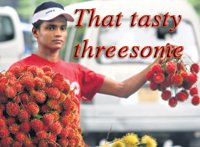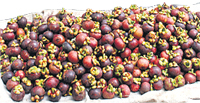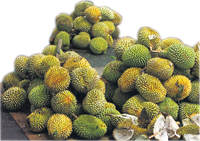|
|
||||||
|
That tasty threesome
In July and August, the fruit stalls here present an extra colourful picture. Rambutan, that rather strange looking oval fruit with bright crimson or yellow skin covered with short fleshy hairs is in season. The word rambutan comes from the Malay, 'rambut' meaning hair.
Ruby red in colour and covered with fine red, green and yellow -tipped hairs, the rambutan is one of the most attractive tropical fruits available in Sri Lanka between May and August. Sri Lankan rambutans are well-known for their irresistible sweetness and juicy flesh. Though it is the most striking of the ‘fruit-medley’, which the season is known for, mangosteen and durian are also purchased and consumed with the same fervour at this time of year! Mangosteen, the dark-red skinned fruit appears in Sri Lanka around April and remains as a seller till October. The inside, when cut open with a knife, contains creamy white segments of tasty flesh with very little seed. Durian is well-known for its pervasive aroma. Beginning from May the season extends up to August. Many wait impatiently to taste this fruit which is considered a delicacy. Some, however, are put off by the pungent smell and never actually taste the creamy golden flesh hidden within the spiny exterior. During the rambutan season, this medley of fruit is displayed in great heaps in roadside stalls. We caught up with a few vendors lining the streets of Colombo. Nimal and Ranjani, a middle aged couple with three teenage children have been making this temporary migration to Colombo from their hometown, Dhunnana, every year for the last 15 years! So is all this effort worth it? “It’s a good business for us,” they say. “We mainly bring the rambutans from Attanagalle, Kirinduwala and Labugama. For the rest of the year we do part time jobs.” We next meet three friends, Lal, Chandrasiri and Lahiru who have been doing this business for the past five years. “The rainy weather affects our sales in that fewer people, be they motorists or pedestrians, stop for fruit. However, the rain helps us to preserve the fruit longer whereas the scorching sun tends to dry up the fruit rendering it useless for sale,” they said. They also lose out when heavy traffic prevents vehicles from stopping, they say. Despite these obstacles, they sell an average of 1500 rambutans every two days. They don’t come cheap though, priced at Rs. 5 to 6, a fruit. Durians seem to be popular not only amongst the locals but also among foreigners of the far-eastern region, they say. For durians, the price ranges from Rs. 90- 150. The mangosteens, which are on average sold at a price of Rs. 10 per fruit are brought from areas such as Kuruvita, say Piyadasa and Susila, yet another husband and wife couple who seem to be taking great joy in dishing out this medley of fruit to the people of Colombo. “We stay up the whole night sometimes and get good sales.”
|
||||||
Copyright © 2006 Wijeya Newspapers
Ltd. All rights reserved. |

 While
most people know about the antioxidant benefits of Vitamins
C and E, far fewer are aware of the incredibly potent antioxidant
power of xanthones, natural chemical substances that demonstrate
a number of pharmaceutical properties: The pericarp or rind,
of the mangosteen is particularly rich in xanthones, which
is said to represent the next generation of powerful phytonutrients;
which are said to change the future of dietary supplements.
While
most people know about the antioxidant benefits of Vitamins
C and E, far fewer are aware of the incredibly potent antioxidant
power of xanthones, natural chemical substances that demonstrate
a number of pharmaceutical properties: The pericarp or rind,
of the mangosteen is particularly rich in xanthones, which
is said to represent the next generation of powerful phytonutrients;
which are said to change the future of dietary supplements.